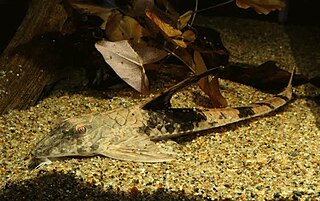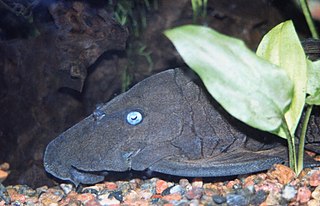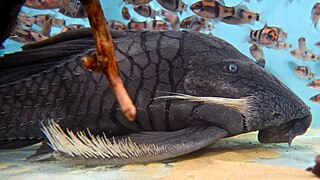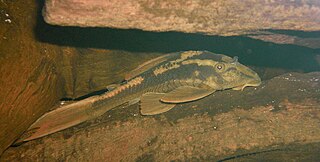
Ancistrus is a genus of nocturnal freshwater fish in the family Loricariidae of order Siluriformes, native to freshwater habitats in South America and Panama. Fish of this genus are common in the aquarium trade where they are known as bushynose or bristlenose catfish. In the aquarium hobby they are often referred to as bushynose or bristlenose plecos instead, but this may lead to confusion as "pleco" usually is used for Hypostomus plecostomus and its allies and is often used as a catchall term for any loricariids remotely resembling that species.

Hypostomus plecostomus, also known as the suckermouth catfish or common pleco, is a tropical freshwater fish belonging to the armored catfish family (Loricariidae), named for the longitudinal rows of armor-like scutes that cover the upper parts of the head and body. Although the name Hypostomus plecostomus is often used to refer to common plecostomus sold in aquarium shops, most are actually members of other genera.

Loricariidae is the largest family of catfish, with over 90 genera and just over 680 species. Loricariids originate from freshwater habitats of Costa Rica, Panama, and tropical and subtropical South America. These fish are noted for the bony plates covering their bodies and their suckermouths. Several genera are sold as "plecos", notably the suckermouth catfish, Hypostomus plecostomus, and are popular as aquarium fish.

Hypostomus is a genus of catfish in the family Loricariidae. They are native to tropical and subtropical South America. H. plecostomus is the popular freshwater aquarium fish formerly known as Plecostomus plecostomus. The taxonomic structure of the Loricariidae is still being expanded by scientists. Hypostomus is a highly species-rich and widely distributed catfish genus.

Panaque nigrolineatus, the royal panaque, royal plec, or royal pleco, is an herbivorous freshwater armored catfish native to Brazil, Colombia and Venezuela where it occurs in the Orinoco and Amazon basins. It is known for being one of the few fish that digest wood. They are arable to survive for a long period of time only on a wood-diet. It maintains this xyliphagous. It grows to a length of 43.0 centimetres (16.9 in) and is a popular aquarium fish.

The blue-eyed plec is a herbivorous freshwater armored catfish endemic to Colombia where it occurs in the Cauca and Magdalena River basins. It is distinguished from many loricariids by being dark grey to black and having bright, turquoise-coloured eyes. Like other species of the genus Panaque, P. cochliodon feeds primarily on submerged wood. Blue-eyed plecs grow to about 30 cm in length and, like other Panaque species, they are clumsy swimmers adapted to staying close the substrate, using their sucker-like mouths to hold on to submerged rocks and wood.

Acanthicus is a genus of large, South American suckermouth armored catfishes native to the Amazon and Orinoco basins, and possibly in Guyana. The name Acanthicus is derived from the Greek, akanthikos meaning thorny, spiny. Fish of this genus are known as lyre-tail plecos. These species are found in large rivers, primarily in areas with a rocky bottom and a moderate or strong current.

Baryancistrus is a genus of freshwater Loricariid catfish. They inhabit flowing sections of rivers, especially clearwater, in the basins of the Amazon and Orinoco in Brazil and Venezuela. The largest species reach up to 34 cm (13 in) in total length.

Hypancistrus is a genus of loricariid catfish originating from the Amazon basin in South America. Unlike many of the other Loricariids, however, some Hypancistrus species are more carnivorous and enjoy meat in their diet. Hypancistrus species are popular aquarium fish, including such popular fish as the zebra pleco and Queen Arabesque pleco.

Loricarioidea is a superfamily of catfishes. It contains the six families Trichomycteridae, Nematogenyiidae, Callichthyidae, Scoloplacidae, Astroblepidae, and Loricariidae. Some schemes also include Amphiliidae. This superfamily, including Amphiliidae, includes about 156 genera and 1,187 species.

Peckoltia is a genus of small South American armored suckermouth catfishes. Many of these fish are popular aquarium fish.

Hemiancistrus is a genus of suckermouth armored catfishes. These species are native to South America. The taxonomy of this genus is complex and unclear, and major work has to be done. Many of these fish are popular aquarium fish.

The Hypostominae are a subfamily of catfishes of the family Loricariidae. Most members are restricted to tropical and subtropical South America, but there are also several species in southern Central America. Hypostomus plecostomus, which is popular in the aquarium trade, has been introduced to several regions far from its native range.

Ancistrini is a tribe of catfishes of the family Loricariidae. Most are restricted to tropical and subtropical South America, but there are also several genus in southern Central America.

Pterygoplichthys pardalis, the Amazon sailfin catfish, is a freshwater tropical fish in the armored catfish family (Loricariidae). It is one of a number of species commonly referred to as the common pleco or "leopard pleco" by aquarists.It can be called 豹紋翼甲鯰 in Mandarin Chinese.

Panaque armbrusteri is a species of fish in the South American armoured catfish family Loricariidae. This species is distributed throughout the Tapajós river, a large tributary of the Amazon River, with similar populations found in the Xingu, Araguaia, Tocantins and Aripuanã rivers, although it is uncertain whether these populations comprise the same or different species. P. armbrusteri is a large loricariid, reaching 43 cm in total length and reportedly weighing up to 1.3 kg.
Panaque schaeferi is a freshwater species of fish from the South American armoured catfish family Loricariidae. Panaque schaeferi is widely distributed throughout the upper Amazon in Peruvian and Ecuadorian rivers, and it has been observed as far down as Santarém, Brazil. Growing to at least 60 cm SL, it is one of the largest, and likely one of the heaviest species of Loricariid. It has been known in the aquarium trade since at least 1996 under various names such as 'Titanic pleco' and 'Volkswagen pleco', in addition to L203 and LDA065 under the L-number code. Juveniles are often confused with Panaque bathyphilus and erroneously called L090c.

Panaque titan is a species of freshwater fish from the South American armoured catfish family Loricariidae. It is known from several rivers in the Napo River basin in Ecuador, where it was perhaps first encountered in 1975, although it was not scientifically described until 2010. The species reaches at least 39.4 cm SL.

Panaque suttonorum, commonly known as the blue-eye panaque, is a species of freshwater fish from the South American catfish family Loricariidae. It is endemic to the Maracaibo Basin in Venezuela. In the wild, the species feeds on algae and reaches 28 cm SL, although it may grow larger in captivity.

Hypostomus basilisko, the basilisk pleco, is a species of armored suckermouth catfish from South America. It is endemic to the Salobra River basin, which is part of the Paraguay River basin in the state of Mato Grosso do Sul in Brazil.



















